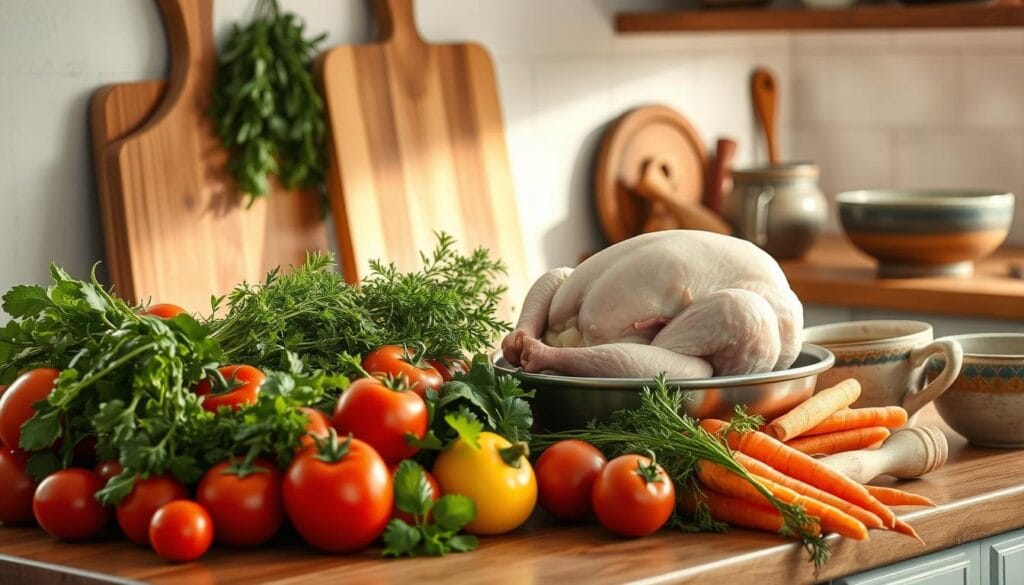There’s something magical about a steaming bowl of homemade soup. It’s more than just food—it’s a warm hug, a memory, and a connection to the past. For many, Grandma’s chicken soup is the ultimate comfort, a dish that brings back feelings of love and care. It’s a recipe passed down through generations, each spoonful carrying a story.
This dish isn’t just about taste. It’s about the time spent together, the laughter shared, and the healing it brings. Whether you’re fighting a cold or simply craving something cozy, this soup is your go-to. Made with simple ingredients like tender chicken, fresh vegetables, and a rich broth, it’s a meal that’s both nourishing and easy to prepare.
Plus, it’s packed with benefits. From immune-boosting garlic to protein-rich broth, every ingredient works together to make you feel your best. And with modern twists like gluten-free or keto-friendly options, it’s a recipe that fits every lifestyle. Dive into a bowl of nostalgia and discover why this soup is a timeless favorite.
Table of Contents
Why Grandma’s Chicken Soup Is Timeless

Few dishes evoke as much warmth and connection as a bowl of homemade comfort. It’s not just about the flavor—it’s the memories, the love, and the time spent together that make it special. For generations, families have gathered around the table to share this dish, creating traditions that last a lifetime.
There’s science behind why this soup feels so comforting. The steam from the broth helps clear your sinuses, while the electrolytes in the ingredients keep you hydrated. Plus, it’s easy to digest, making it perfect for when you’re feeling under the weather.
One secret to its rich taste? Using bone-in chicken. The bones add depth to the broth, creating a flavor that boneless shortcuts just can’t match. Combined with fresh vegetables, it’s a meal that’s both satisfying and nourishing.
Nutritionally, it’s a winner too. With just 189 calories per serving, it’s light yet filling. It also provides 355mg of potassium for hydration and 72% of your daily sodium needs, making it a balanced choice.
Whether you prefer the slow, simmering process of a stovetop (2 hours) or the quick convenience of an Instant Pot (15 minutes), this dish fits into any schedule. It’s a testament to its timeless appeal—simple, wholesome, and always comforting.
Gathering Your Ingredients

The foundation of a great dish lies in the quality of its ingredients. For a comforting and flavorful meal, you’ll need fresh vegetables, herbs, the right type of poultry, and a rich broth. Each component plays a crucial role in creating a dish that’s both nourishing and satisfying.
Fresh Vegetables and Herbs
Start with a mix of fresh vegetables like carrots, celery, and onion. These add both texture and depth to your dish. Garlic is another essential, offering a robust flavor and health benefits. For herbs, consider thyme and parsley—they bring a fragrant touch that elevates the overall taste.
Chopping your vegetables evenly ensures they cook uniformly. You can opt for rough-chopped chunks for a rustic feel or finely diced pieces for a more refined texture. Both methods work, so choose based on your preference.
Choosing the Right Chicken
The type of poultry you use can make a big difference. Bone-in chicken thighs or a whole bird add richness to the broth, while boneless breasts are a leaner option. Each choice has its merits, so pick what suits your taste and cooking style.
Broth and Seasonings
A flavorful broth is the heart of this dish. You can use store-bought broth for convenience or make your own for a deeper flavor. Low-sodium options let you control the saltiness, while additions like Parmesan rind or lemon slices add a unique twist.
Seasonings like poultry seasoning, pepper, and fresh herbs enhance the taste. Experiment with combinations to find your perfect blend. For a gluten-free version, swap traditional noodles for Jovial or Barilla options.
| Ingredient | Purpose | Tips |
|---|---|---|
| Carrots, Celery, Onion | Add texture and flavor | Chop evenly for consistent cooking |
| Garlic | Enhances taste and health benefits | Use fresh cloves for best results |
| Chicken (bone-in or boneless) | Provides protein and richness | Bone-in options add depth to broth |
| Broth | Forms the base of the dish | Low-sodium versions offer better control |
| Herbs (thyme, parsley) | Adds fragrance and flavor | Use fresh herbs for a vibrant taste |
Prepping for the Perfect Soup
Preparation is the key to unlocking the full potential of your dish. Taking a few extra minutes to prep your ingredients ensures a smooth cooking process and a flavorful result. Whether you’re chopping vegetables or handling meat, these steps set the stage for a meal that’s both satisfying and nourishing.
Chopping Vegetables Evenly
Start by dicing your vegetables into consistent ½-inch pieces. This ensures they cook evenly and blend seamlessly into the dish. Use a sharp knife and take your time—precision here pays off in the final texture.
For a rustic feel, you can rough-chop the veggies. If you prefer a more refined look, finely dice them. Either way, uniformity is your goal.
Prepping the Chicken
When working with chicken, decide whether to remove excess fat or leave it for added flavor. Bone-in meat enriches the broth, while boneless cuts are leaner and quicker to cook.
If you’re sautéing, heat a blend of butter and oil in your pot to brown the chicken before adding broth. This step builds depth in flavor. Always use two spatulas to handle hot meat safely.
Pre-measure your spices while the broth heats up. This saves time and keeps the process organized. With these tips, you’re ready to create a dish that’s both delicious and efficient.
Cooking Grandma’s Chicken Soup Step by Step
Crafting a comforting dish starts with the right techniques and a little patience. Each step builds on the last, creating a meal that’s both flavorful and nourishing. Whether you’re a beginner or a seasoned cook, these tips will guide you to success.
Building the Flavor Base
Start by heating a large pot over medium heat. Add a touch of oil and sauté onions until they’re golden. This step layers depth into your dish.
Next, toss in carrots, celery, and garlic. Stir occasionally to prevent sticking. These fresh ingredients form the foundation of your meal.
Simmering to Perfection
Once the vegetables are tender, add your broth and bring it to a rolling boil. Reduce the heat to low and let it simmer for up to 2 hours. This slow process extracts maximum flavor.
If you’re short on time, a pressure cooker can cut this step to just 15 minutes. Both methods yield delicious results.
Adding the Final Touches
While the broth simmers, cook your noodles separately for 8 minutes. This prevents them from becoming mushy. Drain and set aside.
Once the broth is ready, shred the meat and return it to the pot. Stir in the noodles and adjust seasonings to taste. A sprinkle of fresh herbs adds a vibrant finish.
| Step | Key Action | Time |
|---|---|---|
| Building Flavor | Sauté onions and vegetables | 10 minutes |
| Simmering | Cook broth on low heat | 2 hours (or 15 minutes in pressure cooker) |
| Final Touches | Add noodles and adjust seasonings | 5 minutes |
Tips for the Best Chicken Soup
Mastering the art of a comforting dish requires attention to detail and a few expert tips. Whether you’re adjusting flavors or storing leftovers, these insights will help you perfect your recipe.
Adjusting Seasonings to Taste
Balancing flavors is key to a delicious dish. If your broth tastes too salty, add a squeeze of lemon to cut through the saltiness. For a mellow acidity, a teaspoon of honey works wonders.
When handling meat, ensure it’s cooked thoroughly but not overdone. Overcooked meat can make your dish less enjoyable. If this happens, rescue it by adding fresh herbs or a splash of broth.
Storing and Reheating
Proper storage keeps your dish fresh and flavorful. In the fridge, it lasts up to 4 days. For longer storage, freeze it for up to 5 months.
To avoid mushy noodles, freeze your dish without them. Add freshly cooked noodles when reheating. Use Souper Cubes for portioning, making it easy to thaw only what you need.
When reheating, the stovetop is ideal for even heating. If using a microwave, stir halfway through and add fresh herbs post-thaw for a burst of flavor.
| Tip | Benefit | How-To |
|---|---|---|
| Seasoning Adjustments | Balances flavors | Add lemon or honey |
| Storage | Preserves freshness | Use Souper Cubes |
| Reheating | Maintains texture | Stovetop preferred |
“The secret to a great dish lies in the details—seasoning, storage, and reheating all play a part.”
For dietary needs, reduce salt for a keto-friendly version or add rice for a gluten free option. Skim excess fat for a lighter meal. These small tweaks make your dish versatile and inclusive.
Variations to Try
Exploring new twists on a classic dish can bring excitement to your kitchen. Whether you’re looking for a creative spin or dietary-friendly options, there’s a version for everyone. From noodle swaps to global flavors, these variations keep the dish fresh and versatile.
Chicken Noodle Soup Twist
Switch up your noodles for a fun twist. Try wide egg noodles for a hearty texture or pappardelle for a more elegant touch. If you’re going gluten free, Jovial’s rice-based noodles are a great alternative.
For protein, consider using turkey thighs for a richer flavor or tofu for a vegetarian option. Add ginger for an Asian-inspired twist or cumin for a Mexican flair. These small changes can transform the dish into something entirely new.
Gluten-Free and Dairy-Free Options
Adapting this dish for dietary needs is simple. Swap traditional noodles for rice or gluten-free pasta. These alternatives keep the dish light and accessible.
For a creamier texture without dairy, try coconut milk. It adds a subtle sweetness and works well with Thai-inspired flavors. Hearty additions like beans, potatoes, or matzo balls can make the dish even more satisfying.
Using an Instant Pot can speed up the process, making it perfect for busy weeknights. These variations ensure everyone can enjoy a comforting bowl, no matter their dietary preferences.
Conclusion
A comforting dish is more than just food—it’s a way to connect with loved ones and create lasting memories. Whether it’s the flavor or the time spent preparing it, this recipe brings both emotional and physical nourishment.
Encourage your family to gather around the pot and make their own version. It’s a perfect way to bond and share stories. Plus, this dish is ideal for busy families—make it ahead and store it for later.
Here’s a pro tip: Double the batch and freeze portions for quick meals. It’s a lifesaver on hectic days. Don’t forget to share your family’s soup stories online—let’s celebrate the love and tradition behind every bowl.
